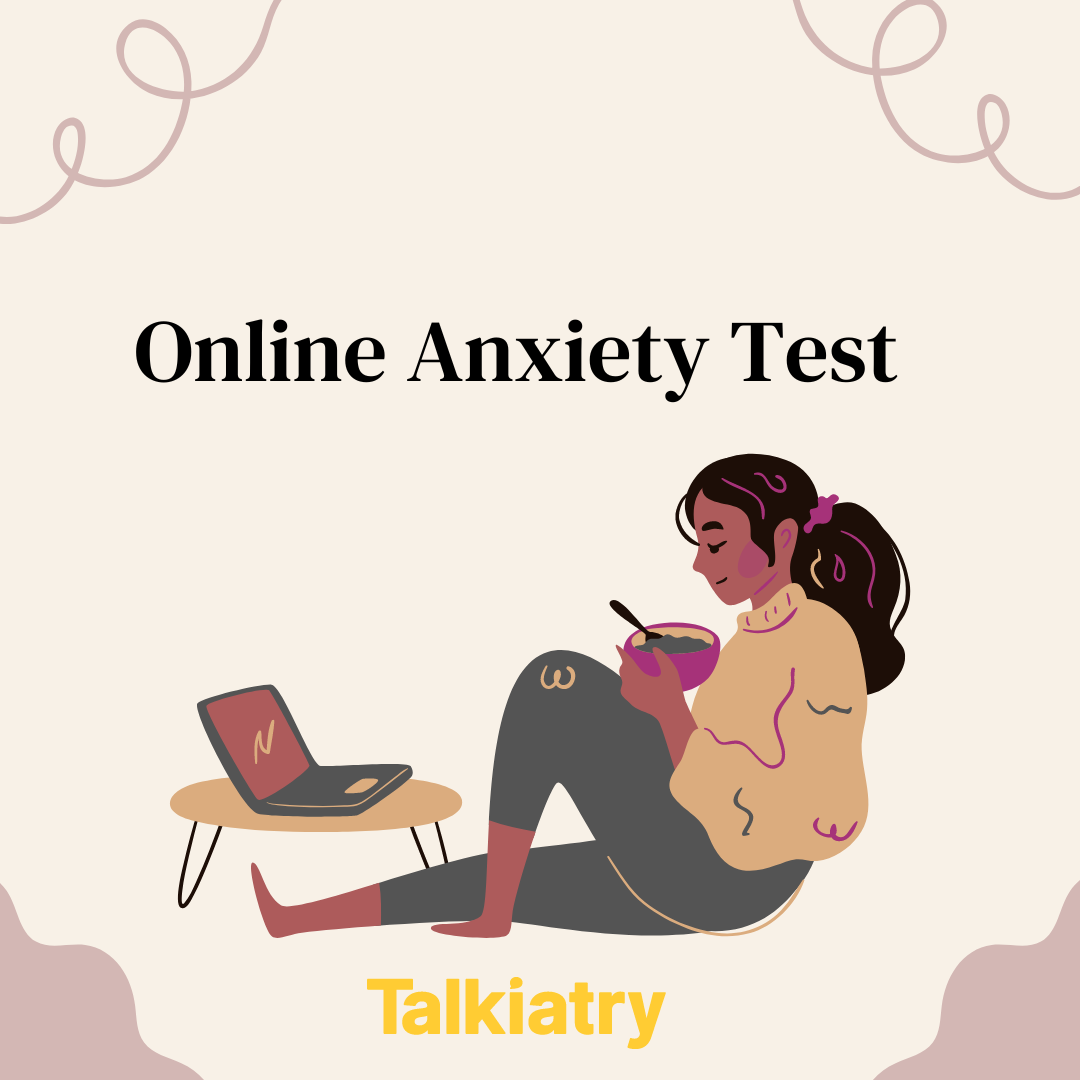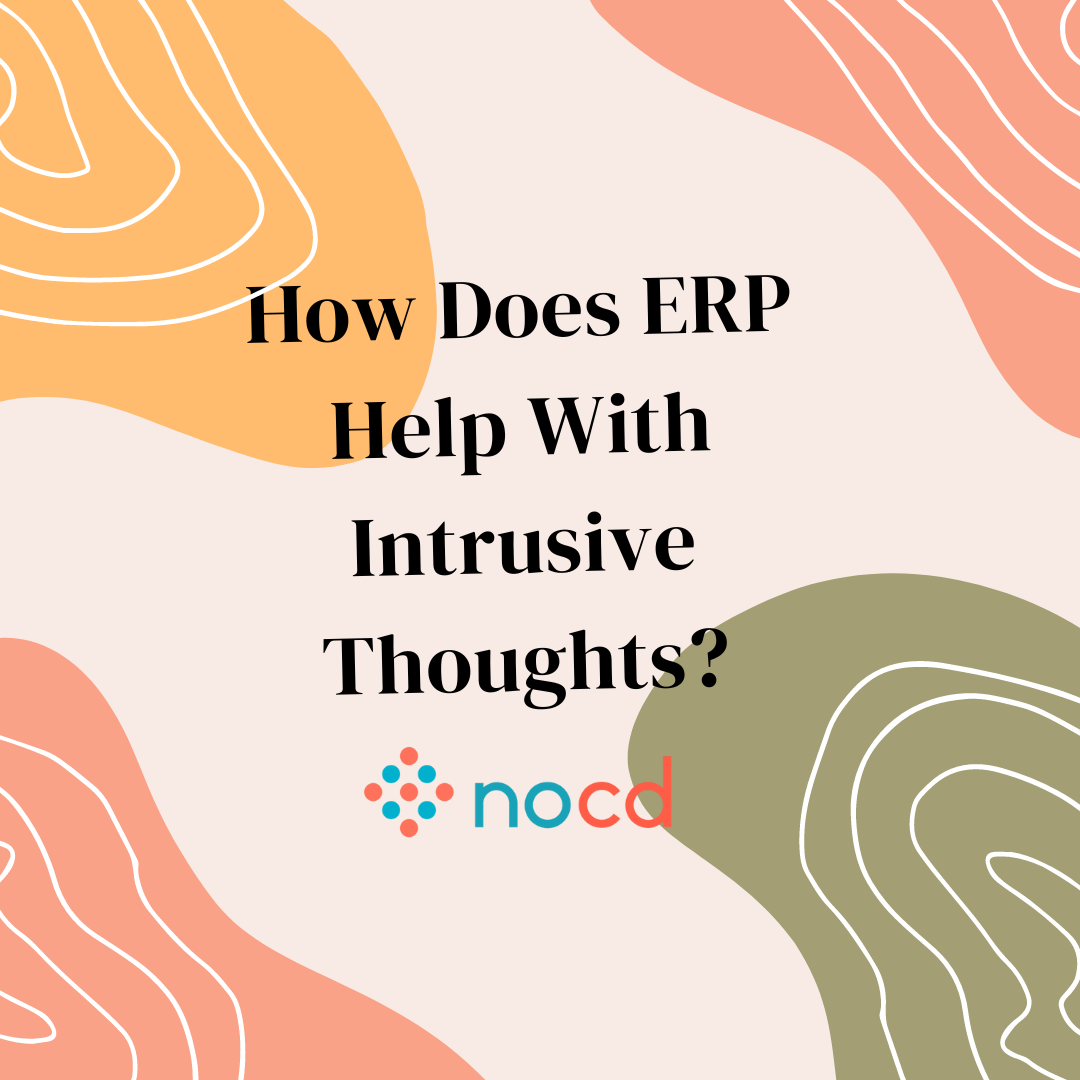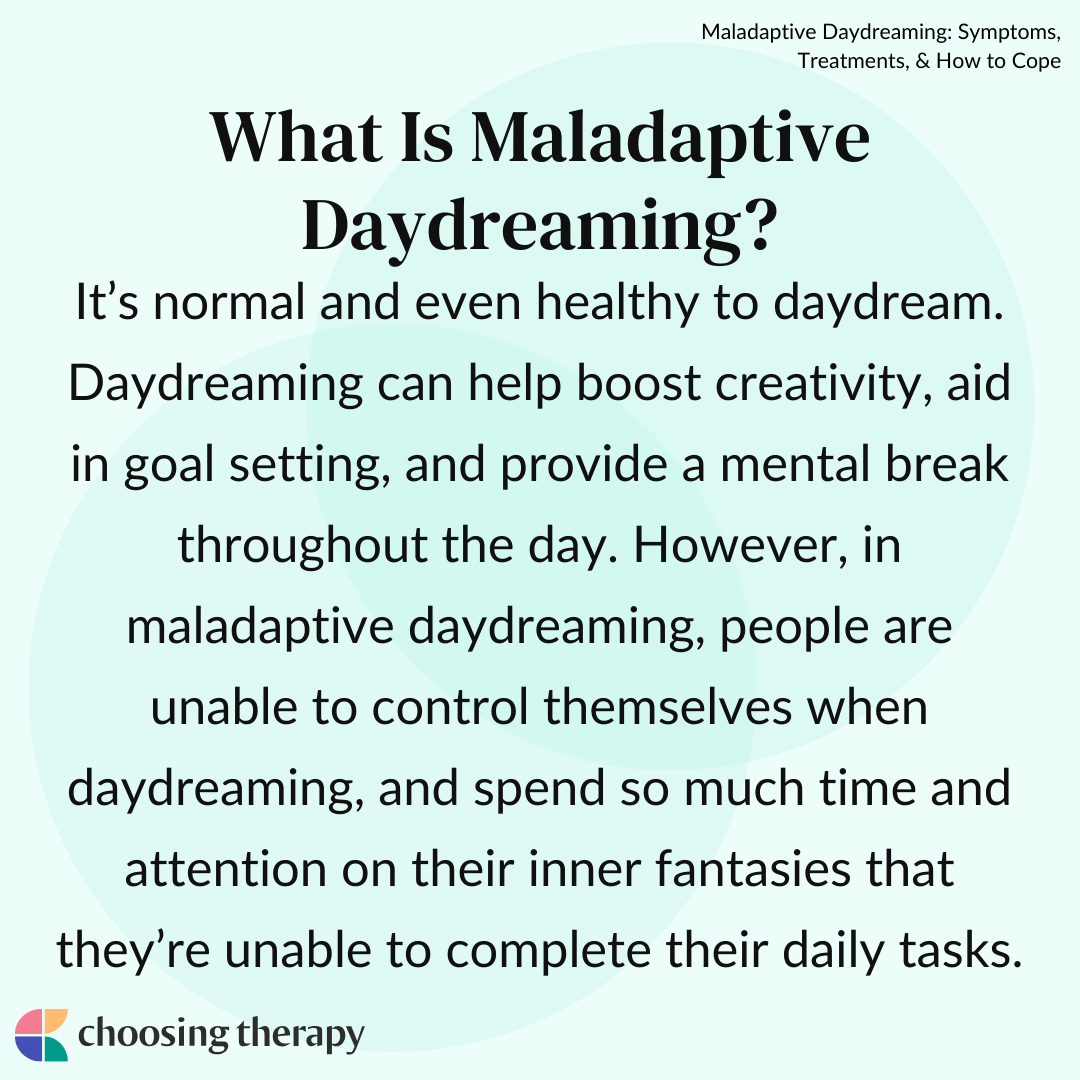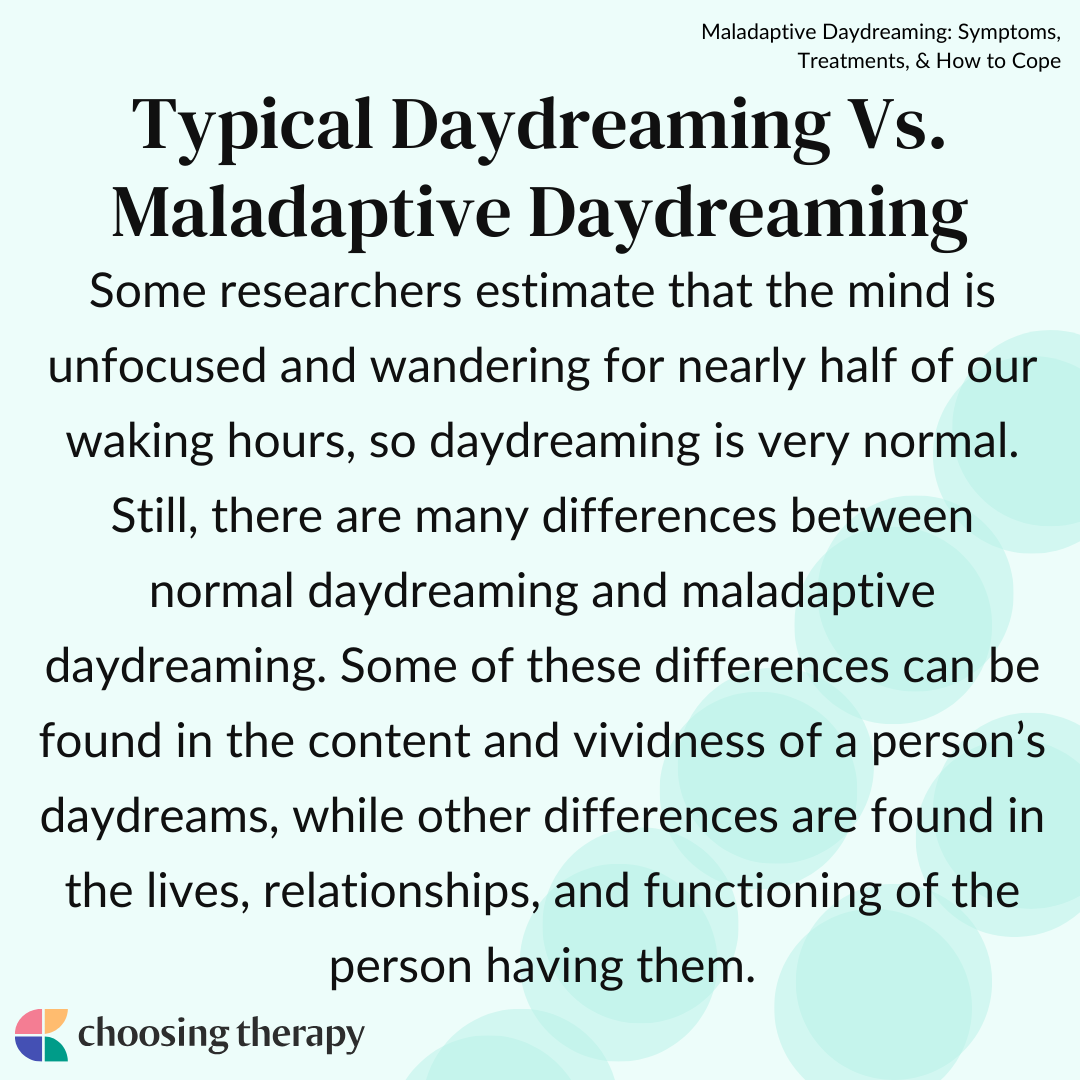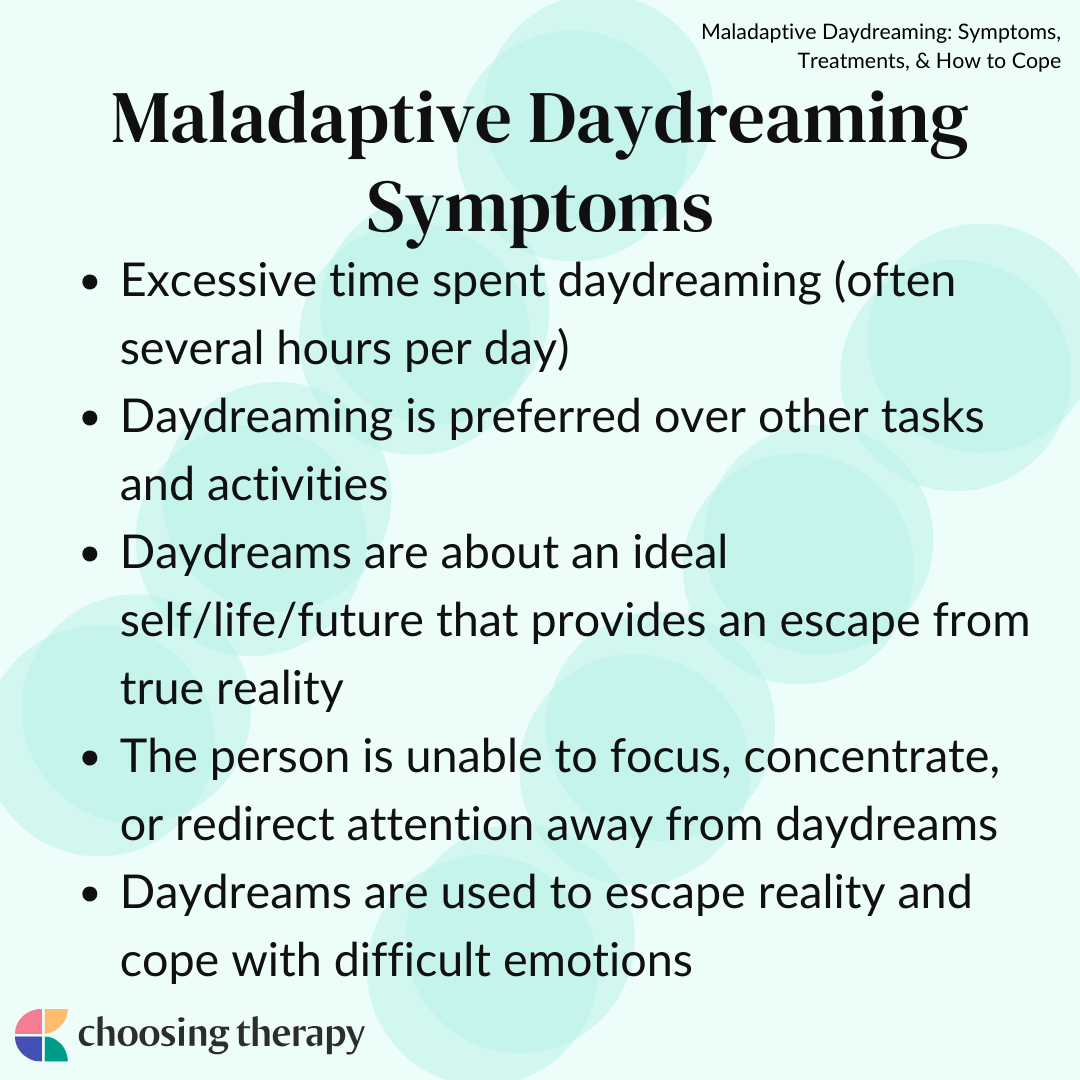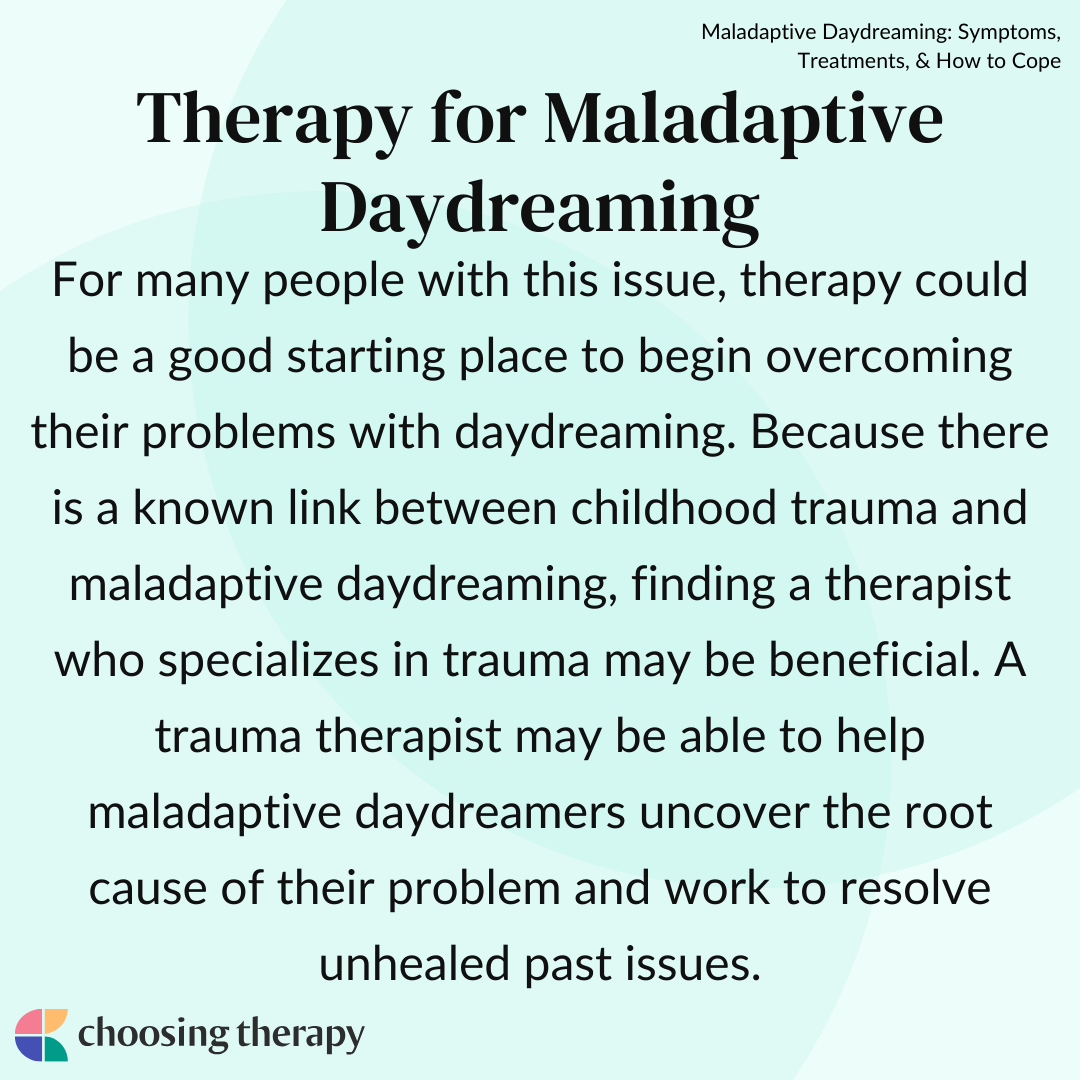Maladaptive daydreaming involves spending an excessive amount of time preoccupied with elaborate daydreams. Some people often prefer these daydreams to their real life, which can result in them neglecting their work and relationships. This behavior usually begins in childhood and is a coping mechanism used to escape when a person is feeling distressed or helpless.1,2,3,4,5
Do your emotions feel extreme?
Therapy can help you be less reactive and calmer. BetterHelp has over 20,000 licensed therapists who provide convenient and affordable online therapy. BetterHelp starts at $65 per week. Take a Free Online Assessment and get matched with the right therapist for you.
What Is Maladaptive Daydreaming?
It’s normal and even healthy to daydream. Daydreaming can help boost creativity, aid in goal setting, and provide a mental break throughout the day.6 However, in maladaptive daydreaming, people are unable to control themselves when daydreaming, and spend so much time and attention on their inner fantasies that they’re unable to complete their daily tasks.
People who have this problem often report spending 4-5 hours per day immersed in daydreams, and usually report that their life, relationships, and work have suffered as a result. Often, they become so engrossed in their daydreams that they even prefer their inner fantasy life to their real life, and may become irritated, annoyed or upset when they can’t escape into their daydreams.1,2,3,4,5,6
Why Do People Start Maladaptive Daydreaming?
According to research, most maladaptive daydreamers started this habit in childhood and used it as a way to escape and avoid childhood trauma or difficult experiences.2,7 Often, their daydreams involve idealized versions of themselves and their lives, providing a place where they can escape from unhappiness, boredom, loneliness, and shame in their real life.7 Unfortunately, this often causes them to neglect their real-life responsibilities, relationships, and daily tasks in ways that lead to problems and impairments.2
Is Maladaptive Daydreaming Disorder a Diagnosable Condition?
Currently, maladaptive daydreaming disorder is not officially recognized as a mental health condition. It is likely that this will change in the near future, especially because there has been a lot of research to support it as a valid psychological problem that some people have.1,3
When Does Fantasizing Become Unhealthy?
Fantasizing becomes unhealthy when it begins to cause distress or impairment in a person’s real life, or when it keeps them from being able to function normally.
Below are some examples of ways that maladaptive daydreaming can cause problems or impairments for people:1,3,6,8
- Being annoyed or frustrated when people distract or interrupt you from daydreams
- Being unable to focus on conversations, tasks, or activities because of daydreaming
- Not being productive or meeting expectations at work or school because of daydreams
- Stopping other social/leisure activities in order to spend more time daydreaming
- Beginning to prefer fantasy and daydreams over real life interactions
- Not being able to control daydreaming in order to focus on other things
- Needing to daydream in order to feel calm or emotionally stable
- Excessive use of music, internet, movies, games, porn, or fan fiction to enhance daydreams
Typical Daydreaming Vs. Maladaptive Daydreaming
Some researchers estimate that the mind is unfocused and wandering for nearly half of our waking hours, so daydreaming is very normal.6 Still, there are many differences between normal daydreaming and maladaptive daydreaming. Some of these differences can be found in the content and vividness of a person’s daydreams, while other differences are found in the lives, relationships, and functioning of the person having them.1,3
According to leading expert and researcher Dr. Eli Somer, maladaptive daydreamers have an “innate capacity for vivid fantasy that creates a powerful sense of presence. This mental activity is reported to be highly rewarding and, therefore, can increase the risk for addiction.” He notes that when daydreams become more important than real life and relationships or keeps them from being able to function, it is often a sign that it has become maladaptive.
Top Rated Online Therapy Services BetterHelp – Best Overall “BetterHelp is an online therapy platform that quickly connects you with a licensed counselor or therapist and earned 4 out of 5 stars.” Visit BetterHelp Online-Therapy.com – Great Alternative In addition to therapy, all Online-Therapy subscriptions include a self-guided CBT course. Visit Online-Therapy.com
Normal Vs. Maladaptive Daydreaming Chart
There are several differences between normal, healthy daydreaming and maladaptive daydreaming, including:
| Normal Daydreaming | Maladaptive Daydreaming |
|---|---|
| Provides a mental ‘break’ | Provides an emotional escape |
| Attention can be restored/redirected at will | Is hard to control, stop or redirect |
| Is less important than real life | Is equal to or more important than real life |
| Is associated with boredom/distraction | Leads to enjoyment and pleasure |
| Does not lead to impairment/problems | Leads to impairments/distress/problems |
| Daydreams are short | Daydreaming can last for hours |
| Is often used to aid creativity/goal setting | Lessens creativity/goals/productivity |
Celebrity Worship: A Specific Kind of Maladaptive Daydreaming
A portion of people who experience maladaptive daydreams report being obsessed with one or more celebrities. There seems to be an association between ‘celebrity worship’ and maladaptive daydreaming, with some people becoming so obsessed with their celebrity idol that this individual becomes one of the most important relationships they have.9
Maladaptive daydreamers with celebrity worship will spend hours at a time researching information about the celebrity and obsessively following their social media accounts, or spending an inordinate amount of time and energy grieving a celebrity death. This is linked to higher levels of unhealthy social media and internet use.
They often describe having intense, unhealthy emotional attachments to celebrities. Often, there is an underlying desire for fame and a strong desire to gain the attention or admiration of the celebrity, which sometimes leads them to engage in obsessive behaviors such as going to unhealthy lengths to attempt to contact the celebrity.9
When Does Maladaptive Daydreaming Become a Concern?
Most people daydream from time to time, but when it turns into a habit that impacts a person’s ability to function in daily life, it becomes a concern that needs to be addressed.
Here are a few signs that daydreaming is becoming a concern:12
- Spending several hours per day daydreaming
- Real-life relationships and responsibilities are being neglected
- Experiencing facial expressions, body movements, and verbalizations in response to fantasies
- Difficulty concentrating on other things
- Intense emotional involvement in detailed fantasies
Maladaptive Daydreaming Symptoms
Maladaptive daydreaming symptoms can include:1,3,6,8
- Excessive time spent daydreaming (often several hours per day)
- Daydreaming is preferred over other tasks and activities
- Daydreams are about an ideal self/life/future that provides an escape from true reality
- The person is unable to focus, concentrate, or redirect attention away from daydreams
- Daydreams are used to escape reality and cope with difficult emotions
- Loss of control over daydreaming, not being able to stop or cut back
- Daydreams become more important than real life activities/relationships
- The person is upset, irritable, or unstable when they can’t daydream (withdrawals)
- Attempts to enhance daydreams with music, movies, porn, fan fiction, etc. (tolerance)
- Daydreams may be so vivid that a person moves, makes vocalizations or facial expressions while experiencing them
Common Co-occurring Mental Health Concerns
Maladaptive daydreaming has features of many other mental health conditions, including:2,3,4,8
- Addictive disorders: Similar patterns of compulsive use, loss of control, tolerance, cravings, and withdrawals
- Impulse control disorders: Similar inability to control the behavior or override urges and impulses to engage in daydreaming
- Attention deficit disorders: Similar patterns of distraction, inability to focus or concentrate, and impaired work and academic performance
- Obsessive Compulsive Disorders: Similar ‘obsessive’ nature of thoughts and daydreams, attributing too much importance to thoughts, and some compulsive behaviors (like internet, porn or social media use) are commonly reported
- Dissociative disorders: A pattern of opting out or mentally escaping during times of stress, hardship or emotional intensity
Common Co-Occurring Disorders
Maladaptive daydreamers commonly report having other mental health conditions, including:4
- Depressive disorders that involve frequent sadness, loss of interest, and low energy which may keep people with maladaptive daydreams from socially interacting with others or engaging in other meaningful and enjoyable activities
- Anxiety disorders including social anxiety, generalized anxiety, or specific phobias, which may cause maladaptive daydreamers to prefer the safety of their inner fantasies
- Posttraumatic stress disorder or a history of childhood trauma, which may cause maladaptive daydreams to escape painful or scary memories, or be linked to a long-standing pattern of using daydreams to escape reality
- Obsessive compulsive disorder and/or skin picking, which sometimes cause obsessive thoughts and compulsive actions and behaviors.
- Behavioral addictions like gambling disorder or excessive use of porn, social media or the internet. These behavioral addictions are often used to intensify daydreams or make them more vivid
- ADHD, which is linked to higher levels of distractibility, trouble concentrating and staying focused, and difficulty being present
Therapists can help you break old habits and create new ones.
BetterHelp has over 20,000 licensed therapists who provide convenient and affordable online therapy. BetterHelp starts at $65 per week. Take a Free Online Assessment and get matched with the right therapist for you.
Causes of Maladaptive Daydreaming
Maladaptive daydreaming is believed to be a natural defense mechanism, and has been traced back to childhood trauma. It is believed that children who experience trauma find ways to escape by creating a rich imaginary world for themselves, and that this pattern sometimes continues into adulthood.2
In studies of adults with this tendency, daydreaming is often described as a way of coping with difficult feelings like shame.7 In their daydreams, they are able to create different, more ideal versions of themselves and their lives. These daydreams become a replacement for their reality, while also meeting their emotional needs for self-worth, connection, and validation.2,7 Often, maladaptive daydreamers report having complex fantasy lives that involve other characters, storylines, and backstories that allow them to ‘rewrite’ themselves and their lives.
Many maladaptive daydreamers report that these storylines play out like a soap opera or movie in their mind. Many use music, images, or other stimuli to intensify their daydreams and make their daydreams feel even more vivid and real. The more realistic these daydreams become, the more the individual feels they can disconnect from their own reality, which often leads to more intense cravings to continuously engage in maladaptive daydreaming.2,8
It’s common for maladaptive daydreamers to become so engrossed in their daydreams that they make physical movements, vocalizations, and facial expressions when they are experiencing these daydreams.1,2,3,8Unfortunately, these elaborate daydreams can disconnect individuals further from real life and relationships, creating a cycle where they need to continuously retreat to their inner fantasies in order to meet their own emotional needs.
Who Is at a Higher Risk for Maladaptive Daydreaming?
Having a mental health diagnosis is the greatest risk factor for developing maladaptive daydreaming. Over half of people with maladaptive daydreaming tendencies also have a co-occuring mental health concern.
Risk factors for developing maladaptive daydreaming include:12
- Anxiety
- OCD
- Depression
- Social isolation
- Boredom
- Trauma history
Complications of Maladaptive Daydreaming
When left untreated, maladaptive daydreaming can cause debilitating complications that may significantly impact a person’s life.
Complications of unaddressed maladaptive daydreaming might include:13
- Interference in work, personal interests, and other pursuits
- Relationship challenges
- Disengagement in social activities
- Feelings of shame and guilt
- Psychopathological symptoms in daily life
How Is Maladaptive Daydreaming Diagnosed?
When you present to a physician or therapist, maladaptive daydreaming is not likely to be their first diagnostic consideration as it is not currently in the Diagnostic and Statistical Manual of Mental Disorders (DSM-5), though many professionals are advocating for it to be considered its own specific diagnosis in the future. Many times, a person presenting with maladaptive daydreaming meets criteria for co-occurring depression, anxiety, or OCD, which serves as the primary diagnosis for treatment. A mental health professional can help explore the role of daydreaming in a person’s avoidance of anxiety, or escape from depression, etc.
Maladaptive Daydreaming Scale
The Maladaptive Daydreaming Scale (MDS) is sometimes used to identify whether a person is struggling with maladaptive daydreaming. This scale has several questions designed to identify some of the most common experiences shared by people who experience maladaptive daydreams.10
While maladaptive daydreaming is not currently a recognized mental health condition, it is likely that if it were to become one in the future, this scale would be utilized as a diagnostic assessment.
There are five major areas that the MDS screens for, including:10
- The content, quality and vividness of daydreams
- The ability to control, stop, interrupt or redirect attention to something else
- The amount of distress caused by maladaptive daydreams
- The perceived benefits, enjoyment or satisfaction a person gets from daydreams
- The extent that daydreaming interferes with daily tasks, routines, and responsibilities
Treatment for Maladaptive Daydreaming
Because maladaptive daydreaming is not currently recognized as a mental health condition, there are no evidence-based treatments for people who struggle with this issue. Researchers have worked to understand that maladaptive daydreaming shares many of the same features as other treatable mental illnesses, and therefore some of the same treatments may be effective.
Dr. Somers, who is considered the leading expert on maladaptive daydreaming, recommends that people who are struggling with this issue seek professional treatment. He states, “If one wishes to better control their fantasy life, I suggest seeking help from a mental health professional who specializes in treating habits and behavioral addictions.” He also notes that, because maladaptive daydreaming is often “used as self-medication for underlying distress,” it may be necessary to treat underlying issues such as trauma or other mental illnesses.
Therapy for Maladaptive Daydreaming
For many people with this issue, therapy could be a good starting place to begin overcoming their problems with daydreaming. Because there is a known link between childhood trauma and maladaptive daydreaming, finding a therapist who specializes in trauma may be beneficial.2,7 A trauma therapist may be able to help maladaptive daydreamers uncover the root cause of their problem and work to resolve unhealed past issues.
Third wave therapies like dialectical behavioral therapy or acceptance and commitment therapy may be helpful for people who struggle with daydreaming. These therapies all focus on teaching people how to use mindfulness as a way to be more present and less distracted by their thoughts and feelings. If you are interested in finding a therapist for maladaptive daydreaming, consider using a free online therapist directory to get started, or you can ask your primary care provider for a referral.
How to Stop Maladaptive Daydreaming
In addition to seeking professional help from a therapist, Dr. Somer also recommends some things that people with maladaptive daydreaming can do on their own to overcome their issue. He recommends, “keep a daily diary to track maladaptive daydreams to gain more awareness,” and also notes, “we have evidence that mindfulness training is beneficial because it provides a necessary skill for staying present in the external reality.”
Dr. Somer also recommends connecting with other people online who struggle with maladaptive daydreaming, noting, “Many people with MD are members of one of the numerous online MD communities on Facebook, Reddit and other social media outlets. In these online forums people find peer support and advice.” Often, this kind of support can help people feel less alone and more supported, while also providing suggestions on what has worked for others.
Because maladaptive daydreamers also tend to use fantasy and daydreams to ‘escape’ from their reality, it may also be helpful to:
- Be aware of when you’re doing it and understand your patterns and triggers
- Begin a mindfulness practice by engaging in guided meditations, breath awareness, or just by working to be more present in your daily life and interactions with others
- Reduce time spent online, watching TV, reading fantasy or fiction, or using music to enhance your daydreams
- Get out more, attend events and meetups, and practice learning how to approach people and start conversations
- Improve your real-life relationships by going out more, meeting new people, and strengthening your current relationships
- Find healthier outlets for stress and difficult emotions, including exercise, artistic outlets, or meditation
- Improve your self-compassion by being kinder to yourself and improving your self-care
- Spend less time feeding into, concentrating on, and adding details to your daydreams
Final Thoughts on Maladaptive Daydreaming
People who struggle with maladaptive daydreaming often describe that it keeps them from being able to function and live a normal life. They may have developed a habit of retreating to their inner fantasies and as a result, do not have the ability to stop this behavior on their own. Seeking professional help from a counselor can be a great starting place for those who need help with maladaptive daydreaming.
With the help of a counselor, it may be possible to uncover the root cause of maladaptive daydreaming and work to find other, healthier methods of coping. Working to enrich daily life and routine and add more meaningful activities and interactions can also help people learn to meet their emotional needs in real-life, instead of needing to use their daydreams to do so.
Additional Resources
To help our readers take the next step in their mental health journey, Choosing Therapy has partnered with leaders in mental health and wellness. Choosing Therapy is compensated for marketing by the companies included below.
Online Therapy
BetterHelp Get support and guidance from a licensed therapist. BetterHelp has over 20,000 therapists who provide convenient and affordable online therapy. Complete a brief questionnaire and get matched with the right therapist for you. Get Started
Online Psychiatry
Hims / Hers If you’re living with anxiety or depression, finding the right medication match may make all the difference. Connect with a licensed healthcare provider in just 12 – 48 hours. Explore FDA-approved treatment options and get free shipping, if prescribed. No insurance required. Get Started
Reduce Drinking
Sunnyside Want to drink less? Sunnyside helps you ease into mindful drinking at your own pace. Think lifestyle change, not a fad diet. Develop new daily routines, so you maintain your new habits for life. Take a 3 Minute Quiz
Mental Health Newsletter
A free newsletter from Choosing Therapy for those interested in mental health issues and fighting the stigma. Get helpful tips and the latest information. Sign Up
For Further Reading
Online Anxiety Test A few questions from Talkiatry can help you understand your symptoms and give you a recommendation for what to do next. How Does ERP Help With Intrusive Thoughts? Obsessive compulsive disorder (OCD) is a psychiatric condition marked by the presence of obsessive thoughts, images, doubts, or urges, followed by compulsive behaviors or acts aimed at easing the distress caused by the obsession. While the content of the obsessions can take many forms, they are always repetitive, persistent, involuntary, and intrusive, and they often result in a great deal of anxiety for the person experiencing them.